
|   |

|   |
Evam 2022 - Showcasing the excellence - Dr. Hareesh N. Nampoothiri e-mail: newn.haree@gmail.com January 24, 2022 The confluence of different art forms is not that rare these days, and we get to see such attempts now and then. However, something which will create an experience of its own and give a long-lasting impression doesn't happen so often. The first evening of the 2022 edition of 'Evam' by Rasa Bodhi premiered one such attempt, featuring Keremane Shridhara Hegde and Parshwanath S. Upadhye. Titled 'Mano Ranga', the production relied on the familiar story of the fateful encounter between Lord Shiva and Manmatha. Unique and impressive 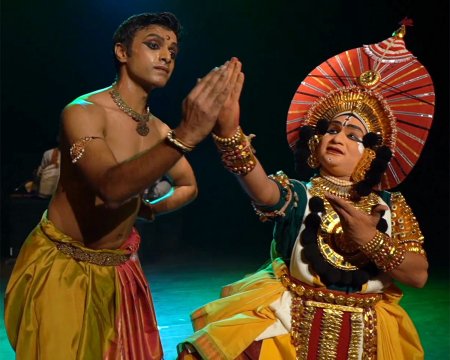 Mano Ranga It is not easy to bring two different forms together without making serious stylistic compromises and impress. Keeping things straightforward often works best, and it proved once again here, as the artists brought together Yakshagana and Bharatanatyam. The dancers, along with their ensemble, delivered a unique experience, nothing like when we watch these forms separately. It indeed was what made 'Mano Ranga' a 'manoranjak' experience. The narration followed the Yakshagana play 'Maaravatara', choreographed by Keremane Shambhu Hegde, grandfather of Shridhara Hegde. On the whole, Yakshagana had the upper hand, and Bharatanatyam was more like a silver lining. With all the vachika, elaborate costume, and prominent percussion, it would've been hard, if not impossible, to contain Yakshagana. Parshwanath had a sensible approach here. Taking the role of Rati to Shridhara Hegde's Manmatha, Parshwanath was there throughout, making his presence felt, with the snippet like choreography portions. Probably, it was also about the storyline. If two equally prominent roles were in place, the production would've had a different outcome. With freely flowing dialogue delivery and innate give and take between the co-actor, Shridhara Hegde was in his element throughout. The interactions between the two on the banks of Lake Manasarovar before Manmatha uses his arrows on Lord Shiva, was particularly amusing. With multiple percussions in place and the singers following two styles, a proper orchestration was essential. Thanks to the music ensembles for their seamless unification, creating the platform for the performers to excel. Along with the bhagavataru Anant Hegde Dantalige, Narasimha Hegde Murur on the maddale, and Gajanan Hegde Murur on the chende formed the Yakshagana ensemble. And for Bharatanatyam, it was vocal by Raghu Ram with Harsha Samaga on the mridangam and Adithya P.V. The initial Vighneswara Sthuthi, without the dancers on the stage, itself was delightful. Lately, artists seem to be obsessed with the moving camera. While it results in compelling visuals now and then, something the audience can't experience in a regular stage show, a meaningful implementation is also critical. It may be about reducing the production costs as well. A camera on a gimbal, done in a single take, without needing to spend long hours in post-production, keeps it minimal. While Arun Jith, the cameraman, managed to capture most of the moments in a good way, there were times when a regular close-up or wide shot would've worked better. An enduring watch 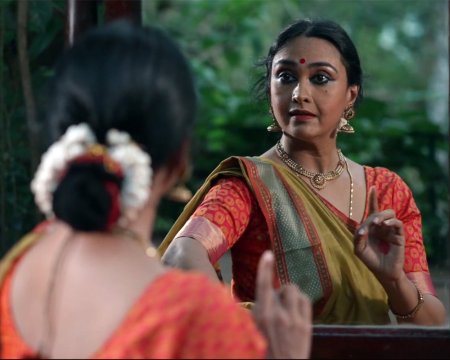 Rajashree Warrier Rajashree Warrier put together her production 'Aparajitha - The ever enduring' in four parts. Each varied visually and musically in approach and presentation, and the dancer made sure the potential of both the media - of dance and video - was well utilized. While the productions by other artists on the first and last day were recorded with live musicians, in a stage arrangement, 'Aparajitha' used recorded tracks and changed the location for each piece. Rajashree Warrier started with "Samastha prapancham..." from Narayana Guru's 'Kalinatakam' set to tune by R.K. Sriramkumar and sung beautifully by T.M. Krishna for Nool Archives in 2020. Cymbals and the sound of ghungroo, a little too loud, were added here in the final mix. The dancer choreographed her gestures, moves, and footwork to the already set mridangam portions and presented with elan. Moving on, in a sitting posture Rajashree Warrier explored samanya nayika in "Yaradi enthan vasalil...", a padam by K. N. Dhandayudapani Pillai. Capturing the viewer's attention to her face and conveying the ideas mainly through her eyes, using gestures only when it was essential, Rajashree made it extraordinary. Dancer turning to a mirror placed behind, and camera switching focus to the reflection, to show the heroine's inner thoughts was interesting. The camera switched between close-up and medium shots, making it visually appealing. The soulful rendering by the dancer herself, without any accompaniments, also enhanced the experience. The title piece 'Aparajitha' had multiple layers accentuating a women's social life with daily chores and her musings and desires. The short voice-overs gave a premise for the viewers to tune in, but the rest was left for them to interpret. There's this attic where she's left in the dark, where her fights ended up shadowy. She watches from the balcony, moves through the corridors, and climbs down the stairs. However, it is not easy to pass through the invisible walls of patriarchy. She's parakeeya not by her choice, but out of necessity, the dancer establishes. Does the nayika find her liberation at the end? It again depends on the viewer and how one defines freedom. The camera angle, frames, and editing - it was all thoughtful, communicating the dancer's intents effectively. The intriguing music created with violin (Attukal Balasubramanyam) and mizhavu (Kalamandalam Sajikumar) aptly complemented the theme. Rajashree Warrier concluded with an Oriya keertan "Brindabono bilasini..." - a pleasant watch with the space itself getting some light, compared to the previous pieces. Imagined as a conversation between birds Shuka and Shari, the music was refreshing, and so was the choreography. Rajashree's abhinaya, this time constantly moving and with footwork, made it all engaging. Tales of devotion 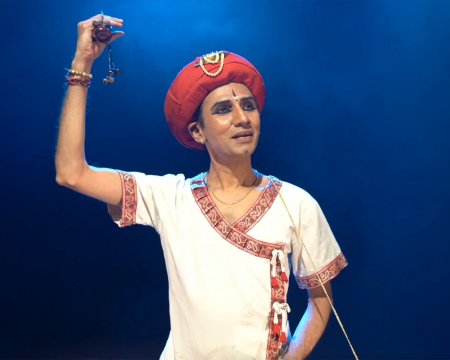 Praveen Kumar Praveen Kumar took the audience for a wari, a pilgrimage to the holy town where Lord Vithala resides through his production 'Pandharpur'. After an invocation on Vithala, Praveen appeared as a wakari, and the tales he sang and danced became the crux of the presentation. Praveen Kumar is an artist who has a poised approach to his dance and watching him perform is so comforting. 'Pandharpur' was no different. The opening invocation itself had all the essentials to inspire the viewers. A lot of storytelling happens throughout the presentation, and Praveen presented it with the right amount of sentiments and elaborations. In the first story of Namadev, though the description mentioned both the parents, the dance focused on the father character alone. A man longing for a child without his wife not coming into the scene seemed incomplete. The story of Narahari, an ardent devotee of Lord Shiva, gave Praveen Kumar a chance to add some more dance elements by praising the virtues of the deity. The climax was Narahari realising Vithala as a manifestation of Shiva and Vishnu. It was another instance where Praveen excelled, and with this, he culminated in a high note. The music ensemble had Ganesh Desai on vocal, D.V. Prasanna Kumar on the nattuvangam, Harsha Samaga on the mridangam, Mahesha Swamy on the flute, and Anoor Prabodh on the pakhavaj. Though the moving camera was once again in play here, it was better managed or being a solo made it possible. And there were more cuts in between, giving the cameraman Arun Jith a chance to readjust. The lighting patterns created by Nagaraj T.M. were interesting, especially in the scene where blindfolded Narahari experiences Lord Shiva was well executed. However, the projection of the ripples in the back in one instance and the small cut scene holding a plank with the reflection of Lord Vithala felt unnecessary. One striking issue was the not-so-good audio, reminding one of an old radio recording. Maybe, the live audio was not separately recorded in proper stereo or missed to mix it later in post-production. A platform for youngsters 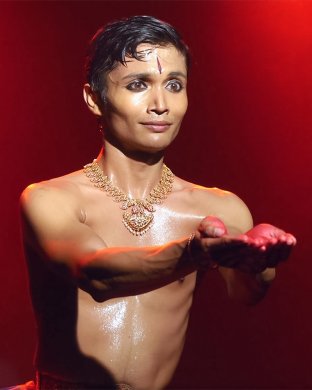 Pritam Das 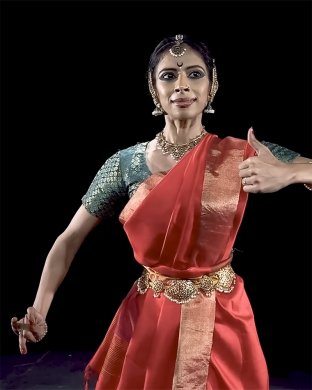 Eesha Pinglay Each day started with a platform performance meant for aspiring dancers. Eesha Pinglay and Pritam Das, disciples of Vaibhav Arekar and Rama Vaidyanathan respectively, were featured on the first two days. Eesha chose to perform "Dhanya te sansari...", an abhang put together into a varnam-like structure, and Pritam Das did a 'Devi Sthuthi' starting with an alarippu. Both noted works of the respective gurus, oft-performed by themselves or by their disciples, Eesha and Pritam had to execute well, which they both managed to do appreciably. Both dancers, especially Pritam, could bring more of their persona into the presentation. Reminding of Rama Vaidyanathan in every move and mannerism may not be the best way forward for him as a dancer. The final day had Gowri Sagar, a disciple of Sathyanarayana Raju, presenting 'The Undying Memory'. Dedicated to those who fail to leave their unpleasant memories behind and embrace the present, Gowri's attempt was more of an emotional journey. Even the dance portions reflected the heroine's conflicts, and Gowri's abhinaya was soulful. Conceptualized and choreographed by herself, she also tried to utilize the medium to her advantage. However, a little more disciplined camera work and editing would've made it more appealing. 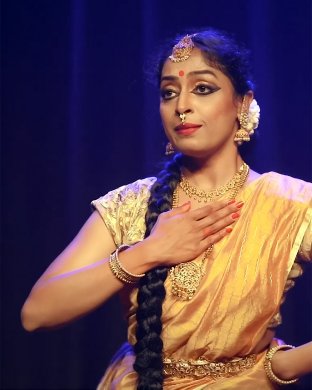 Gowri Sagar Streamed through the Tikkl online platform as a multi-day event between the 14th and 16th of January, the videos will be available to watch till the second week of February. Team Rasa Bodhi, right from the start of Evam in 2016, is committed to making the dance ventures sustainable, and hence the show is ticketed. Interested rasikas may visit EVAM 2022 - GLOBAL to avail the ticket, watch the performances, and support the cause.  Dr. Hareesh N. Nampoothiri is a visual design consultant by profession, an art lover by obsession and an author, writer, photographer, editor, lyricist, and director by passion. He is also the founder and chief editor of Artograph, a bimonthly e-magazine on arts. |